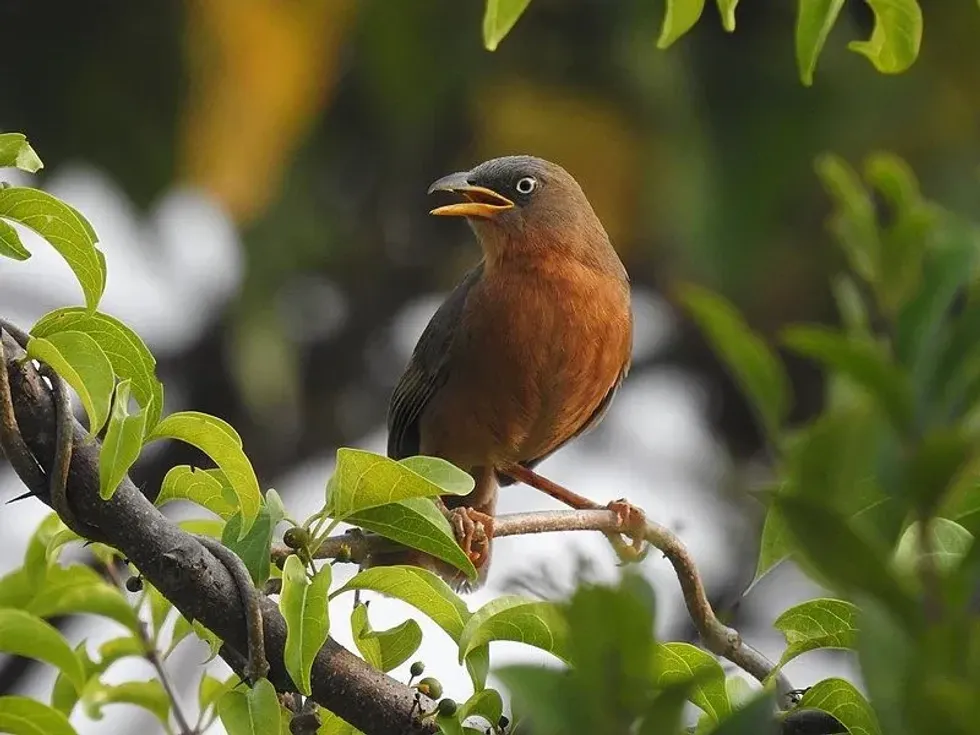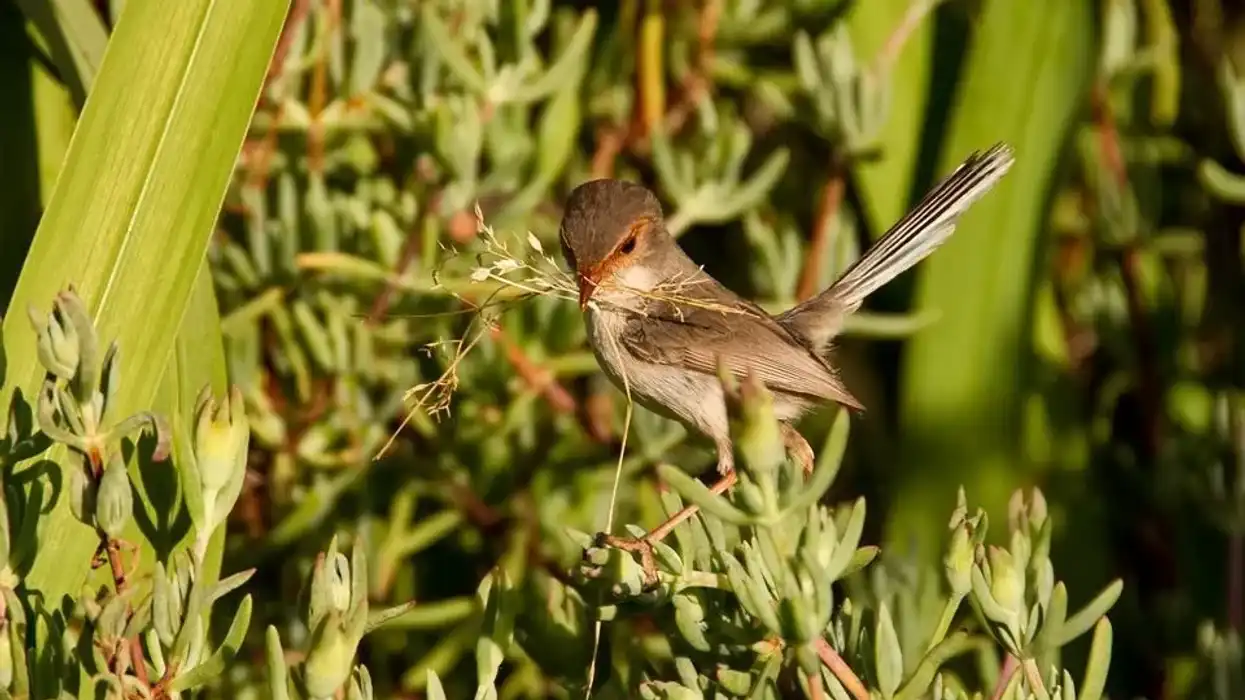The rufous babbler (Argya subrufa) is a species of bird endemic to the Western Ghats of southern India. There is also another species of the same genus called the orange-billed babbler (Argya rufescens) endemic to Sri Lanka.
This bird species is also known by the names Sri Lankan rufous babbler and Ceylon rufous babbler.
The members of the Leiothrichidae family, genus Argya of the order Passeriformes, both these bird species are also known by the scientific names Turdoides subrufus and Turdoides rufescens respectively.
The rufous babbler was formerly placed under the genus Turdoides, but after a study in 2018, the bird was put under the new genus Argya. The same has been the case with the species Sri Lankan rufous babbler.
The rufous babbler from India has a dark brown plumage complemented with a long tail. The birds are mostly seen foraging in noisy flocks near open hillsides with a mixture of grass, bracken, and forest. The bird species feed on insects and berries mostly. They are common in open forest areas, scrub, and grassy hillsides.
The Ceylon rufous babbler bird is orange-brown below and dark above. The bird species have an orange bill and grey crown and nape.
The bird is a noisy one and can be recognized in a forest by the continuous chattering, squeaking, and chirping produced by the flock of these birds. They are found in wet zone forest areas. They are similar to the common babbler in size.
For more relatable content, check out these jungle babbler facts and bowerbird facts.
Rufous Babbler Interesting Facts
What type of animal is a rufous babbler?
The rufous babbler is a species of bird in the family Leiothrichidae.
What class of animal does a rufous babbler belong to?
These birds belong to the class of Aves in the kingdom of Animalia. There are two subspecies of the rufous babbler species from India.
How many rufous babblers are there in the world?
The population of the rufous babbler bird found in India is not known. However, the distribution of the species of birds is quite widespread in a range of areas spread across 104247.5 sq mi (270,000 sq km). The Sri Lankan rufous babbler birds on the other hand have their population depleting quite a bit giving the status Near Threatened.
Where does a rufous babbler live?
The rufous babbler from India (formerly Turdoides subrufus) is endemic to the Western Ghats of southern India. The birds are found in the south of Mahabaleswar south to the Palni hills.
From there, the range is to the east into the Shevaroy hills. The first subspecies of the bird (A.s. subrufa) are found in the Western Ghats to north Kerala, Chennai, and Nilgiri Hills.
The birds from the other subspecies (A.s. hyperythra) are found in southwest Chennai and Kerala). The Sri Lankan rufous babbler birds are commonly found in Kitulgala and Sinharaja of Sri Lanka.
What is a rufous babbler's habitat?
The rufous babbler forages in wetter regions than jungle, common, and large grey babblers. The former birds are known to forage in dense undergrowth in foothill forest and forest edge.
The bird is common in open forests, scrub, and grassy hillsides. The Sri Lankan rufous babbler is found in rainforests. The birds are found in the wet zone of the forests.
Who do rufous babblers live with?
These birds always move in flocks. The flocks can be very large. The Sri Lankan birds live in flocks of 7-10 birds or more.
How long does a rufous babbler live?
The lifespan of the bird is not known.
How do they reproduce?
The breeding season of the rufous babbler is from February to November. The nest is shaped like a small cup and kept in the fork of a tree. There are two to four eggs usually, but mostly three dark glossy blue eggs are seen.
The Sri Lankan rufous babbler is very good at concealing the nest, so very little is known about the nest of these birds. The birds are known for breeding in the month of March to May.
Eggs are dark greenish-blue in color and there are two to three eggs in a clutch. Eggs get laid in the month of March.
The nest of the Sri Lankan rufous babbler bird is made in a tree, concealed in dense masses of foliage.
What is their conservation status?
The conservation status of the rufous babbler from India has been categorized as Least Concern by the IUCN Red List. There is no danger to the population currently.
However, the status of the Sri Lankan rufous babbler is categorized as Near Threatened by the IUCN Red List. The population is decreasing rapidly in the areas the species inhabit and according to the criteria set by the IUCN Red List, conservation practices for the bird are required immediately.
Rufous Babbler Fun Facts
What do rufous babblers look like?
The rufous babbler found in India is a large bird with dark olive-brown plumage and a grey forehead. A rufous tinge can be seen on the wing feathers. The bird has a pale white-yellow iris with dark lores.
The underside of the species is dark rufous in color. Pale coloration is present in the center of the belly and throat. Black shafts are seen on the feathers in the forehead.
The Sri Lankan rufous babbler has a plain orange-brown plumage below with a darker coloration above. The birds are easily differentiated from other species by rufous coloration and bright orange bill and legs. Both sexes look the same.
How cute are they?
They are considered quite cute.
How do they communicate?
The call of the rufous babbler sounds like a loud ringing 'treenh-treenh' call.
How big is a rufous babbler?
The length of the rufous babbler is 9.84-10.23 in (25–26 cm). The wing is around 3.54 in (9 cm) long and the tail is around 4.33 in (11 cm) long.
The Sri Lankan rufous babbler bird is similar in size and form to the common babbler. However, the common babbler birds do not have the same attractive plumage and the orange beak and legs as the former bird.
How fast can a rufous babbler fly?
The speed is not known. However, short rounded wings mean the birds have a weak flight.
How much does a rufous babbler weigh?
The weight is not known.
What are the male and female names of the species?
Males and females are not given different names.
What would you call a baby rufous babbler?
A baby rufous babbler is called a young or chick.
What do they eat?
The main diet of rufous babbler consists of insects and jungle berries.
The Sri Lankan rufous babbler (Argya rufescens) was earlier considered a race of the jungle babbler (Argya striatus). The jungle babbler found in India has a range of diets. It includes insects like grasshoppers, ants, wasps, cockroaches, termites, beetles, moths, crickets, spiders, caterpillars, and flies.
Are they friendly?
They travel in flocks, so they are considered quite sociable. There is not much interaction with humans.
Would they make a good pet?
They are not considered pets by humans.
Did you know...
Babblers of the order Passeriformes has always been a source for new research for ornithologists and has always been fascinating.
They are insectivores and mostly feed on insects foraging on the ground. However, they also feed on berries.
What noise does the rufous babbler make?
The rufous babbler makes a loud 'treenh-treenh' call.
Do rufous babblers migrate?
No, they do not migrate.
Here at Kidadl, we have carefully created lots of interesting family-friendly animal facts for everyone to discover! For more relatable content, check out these giant cowbird facts and giant ibis facts for kids.
You can even occupy yourself at home by coloring in one of our free printable babbler coloring pages.










